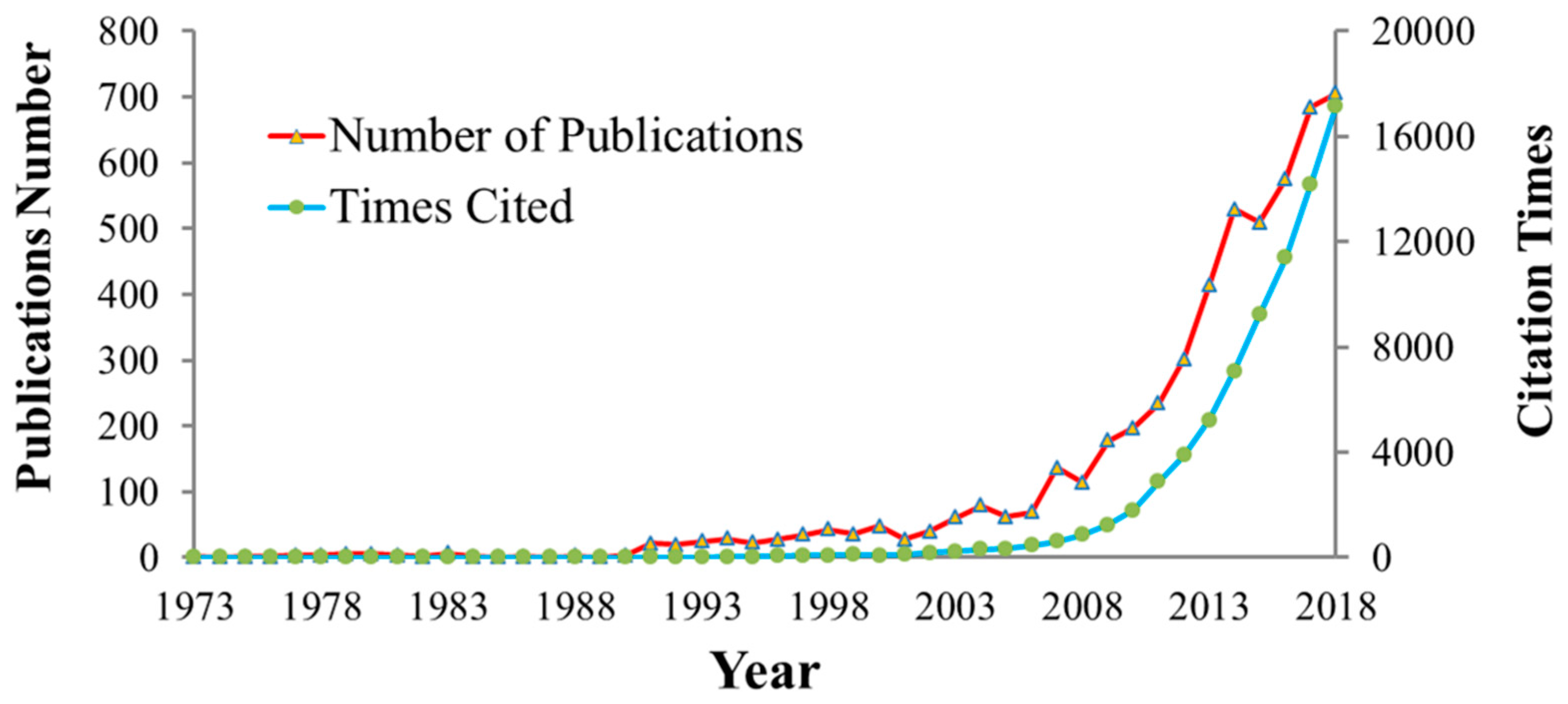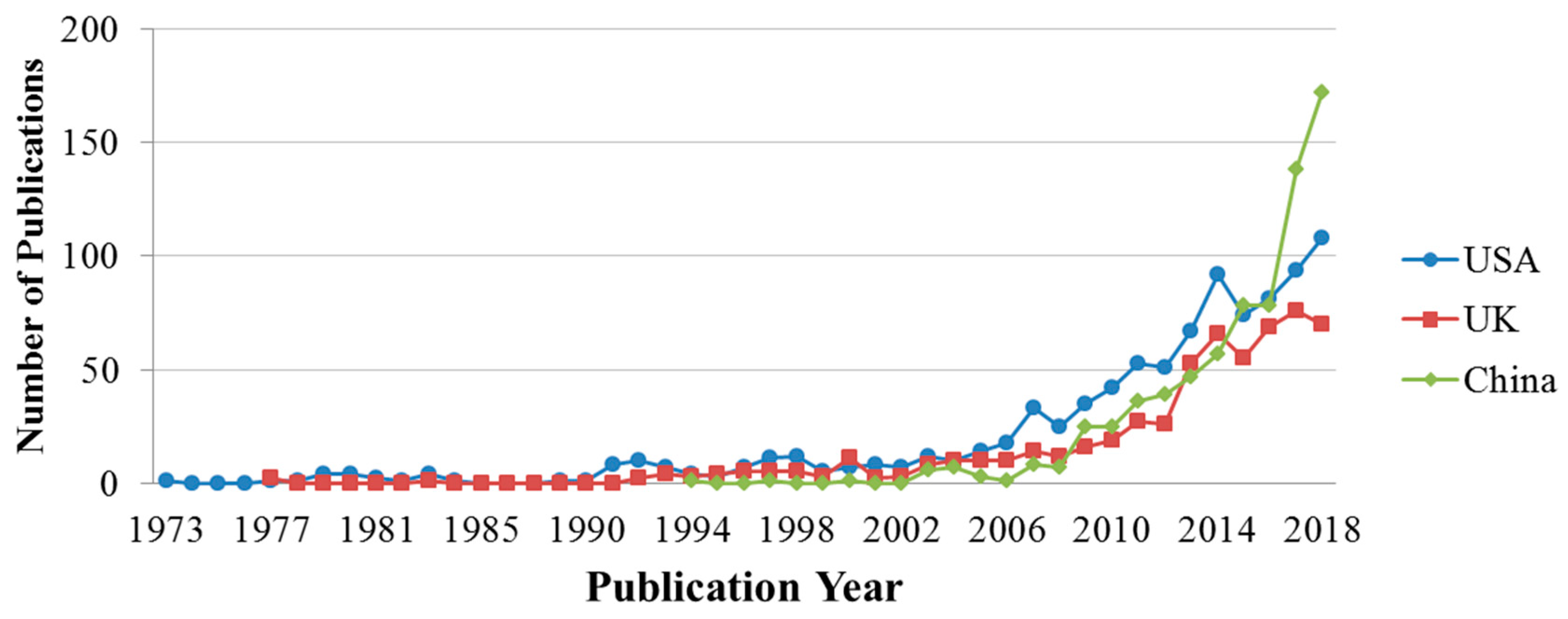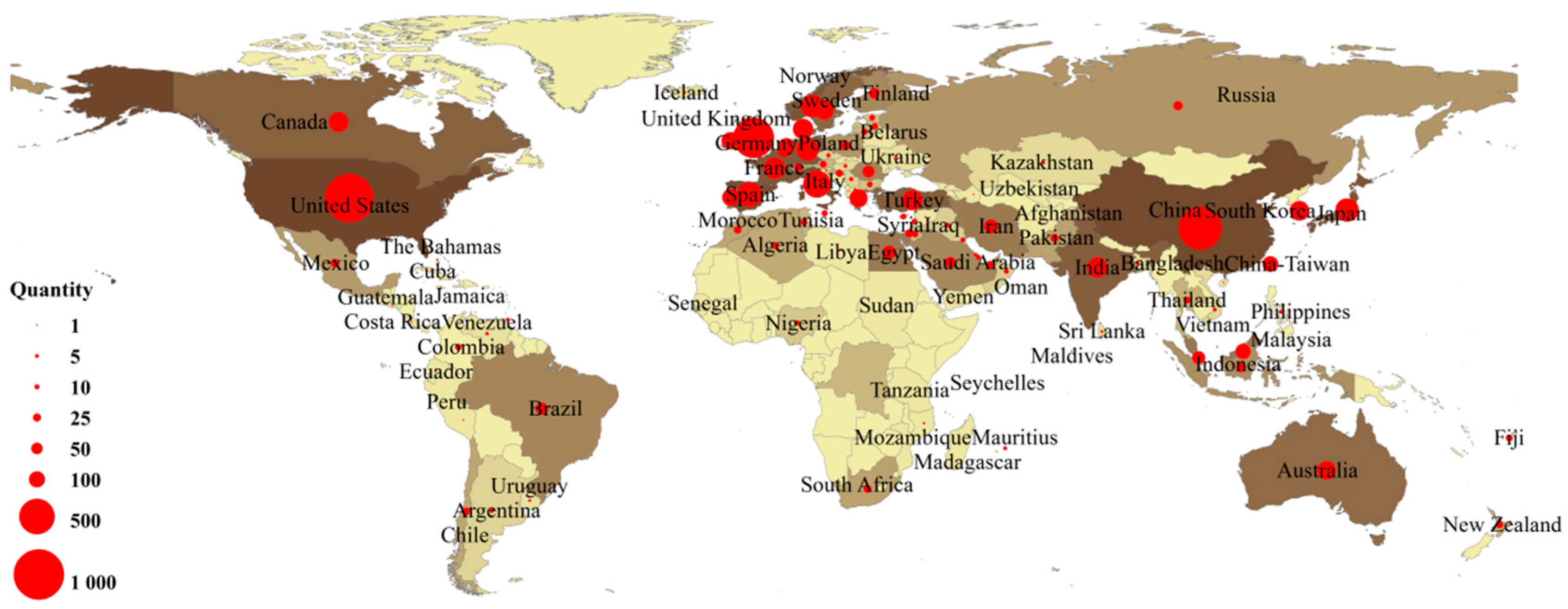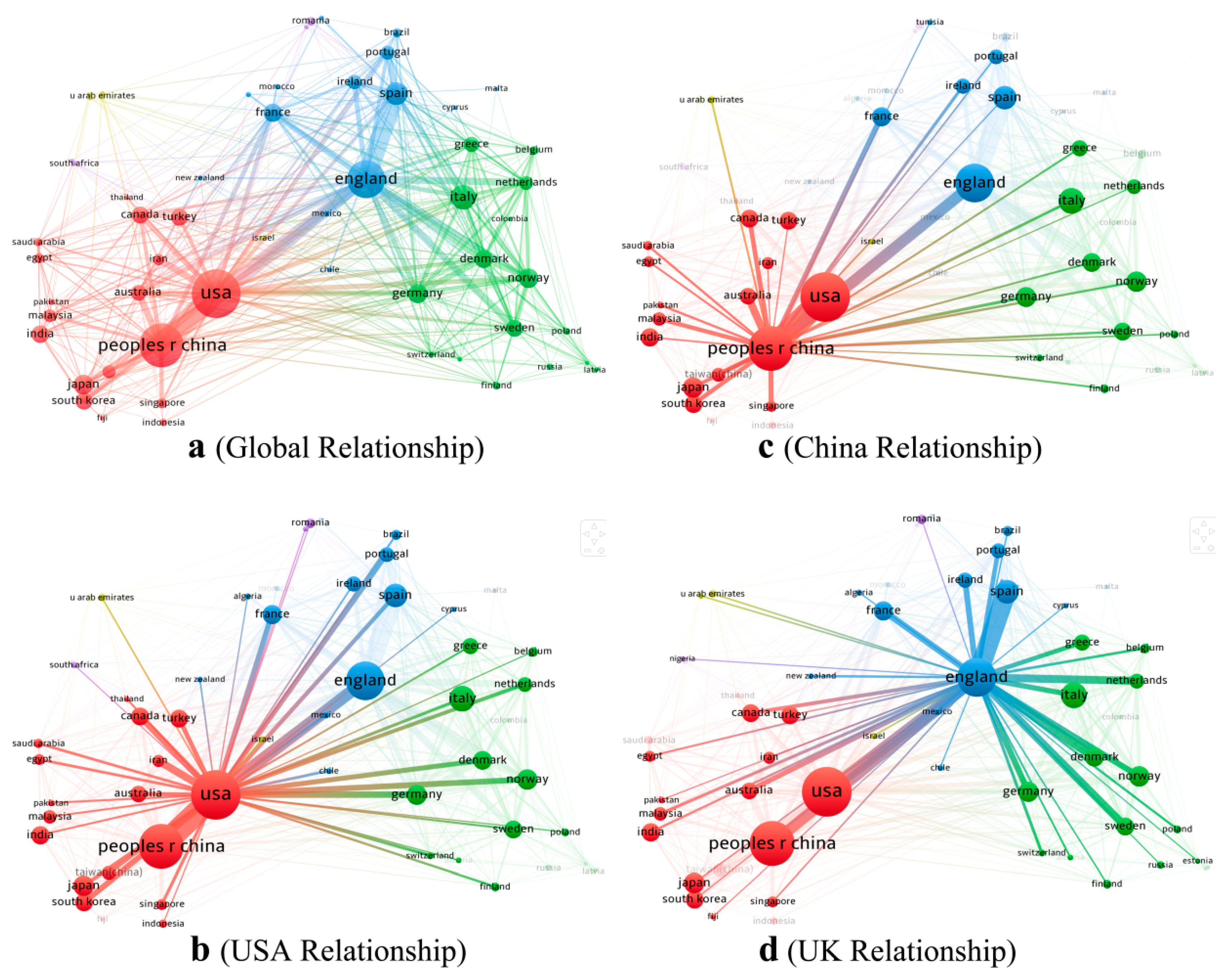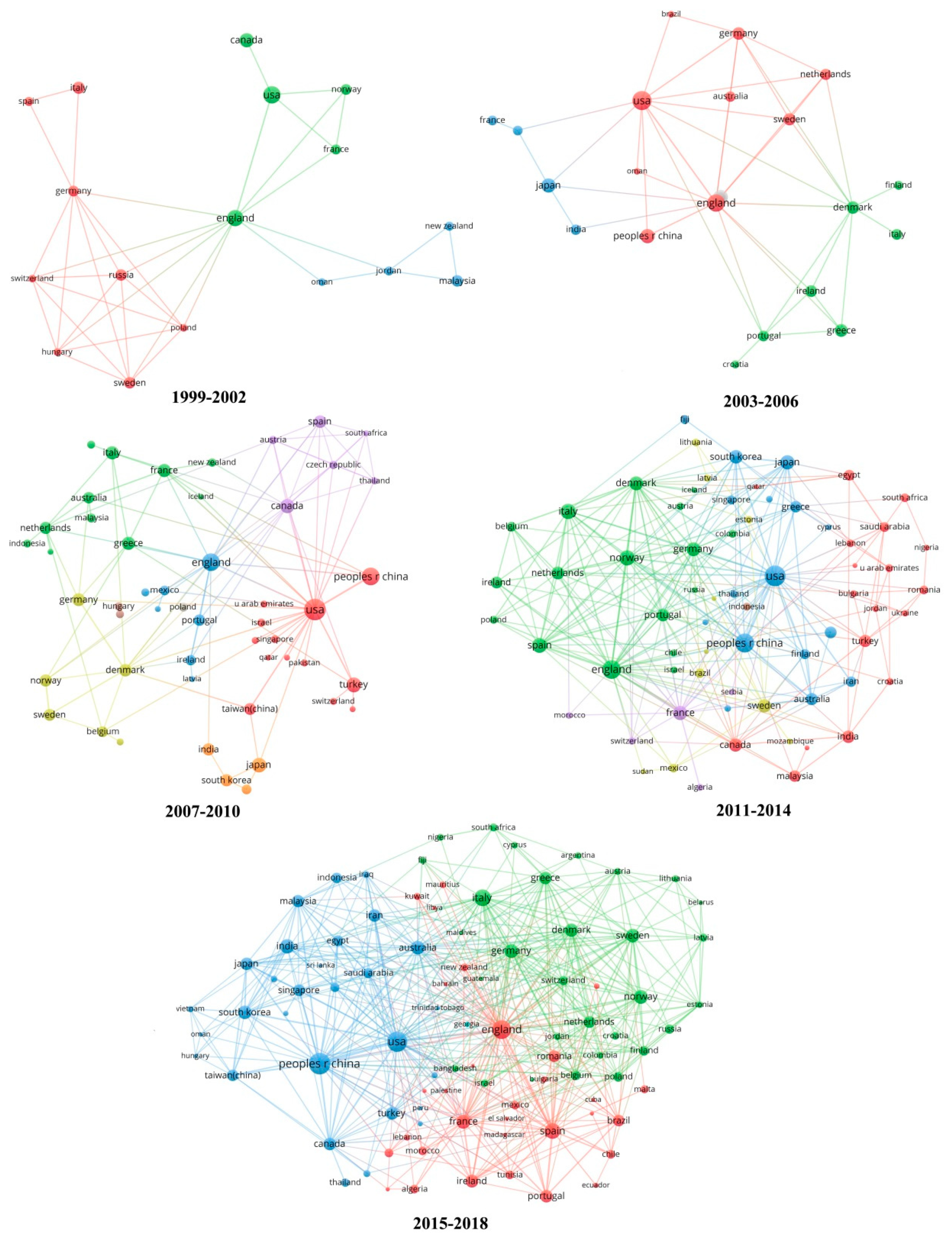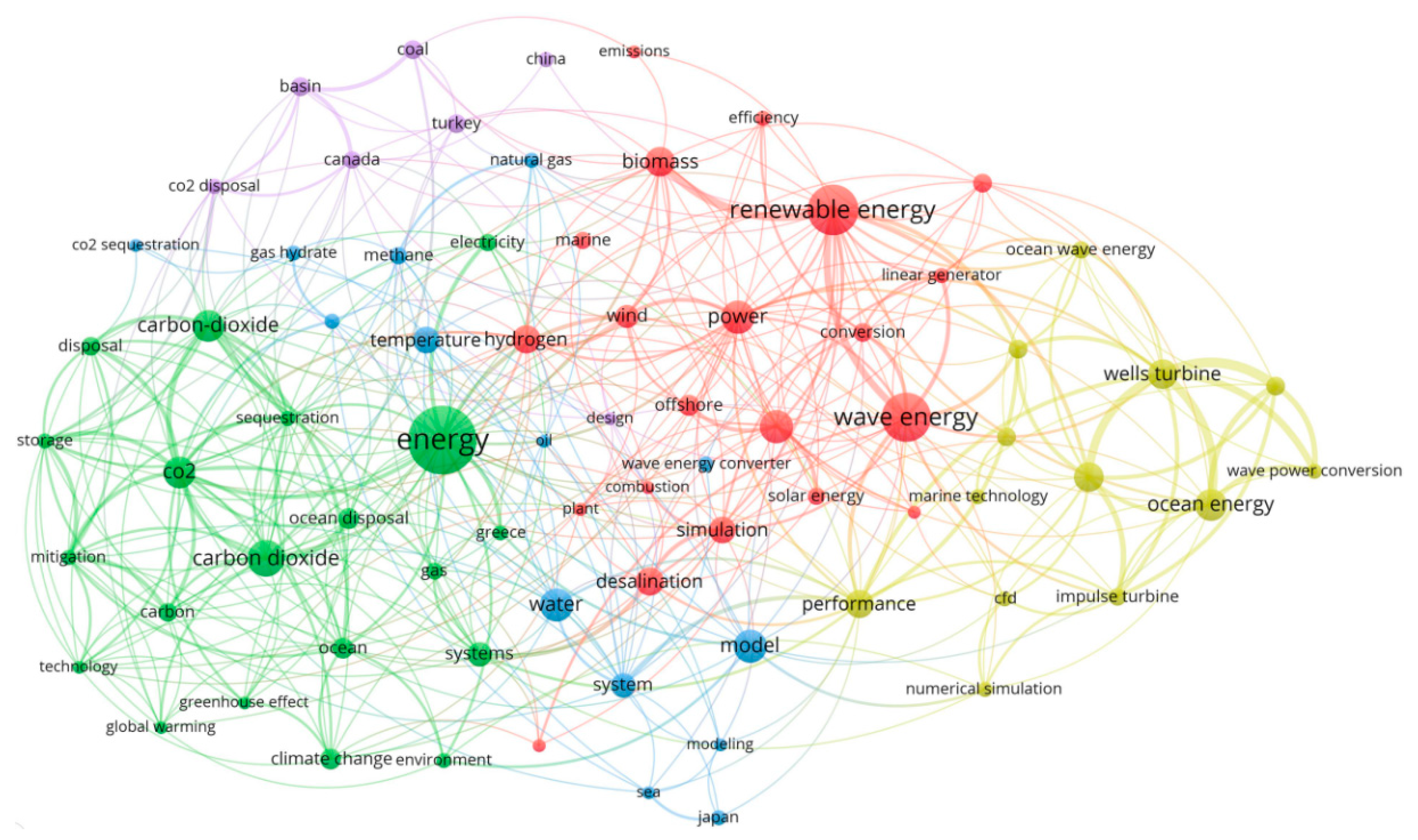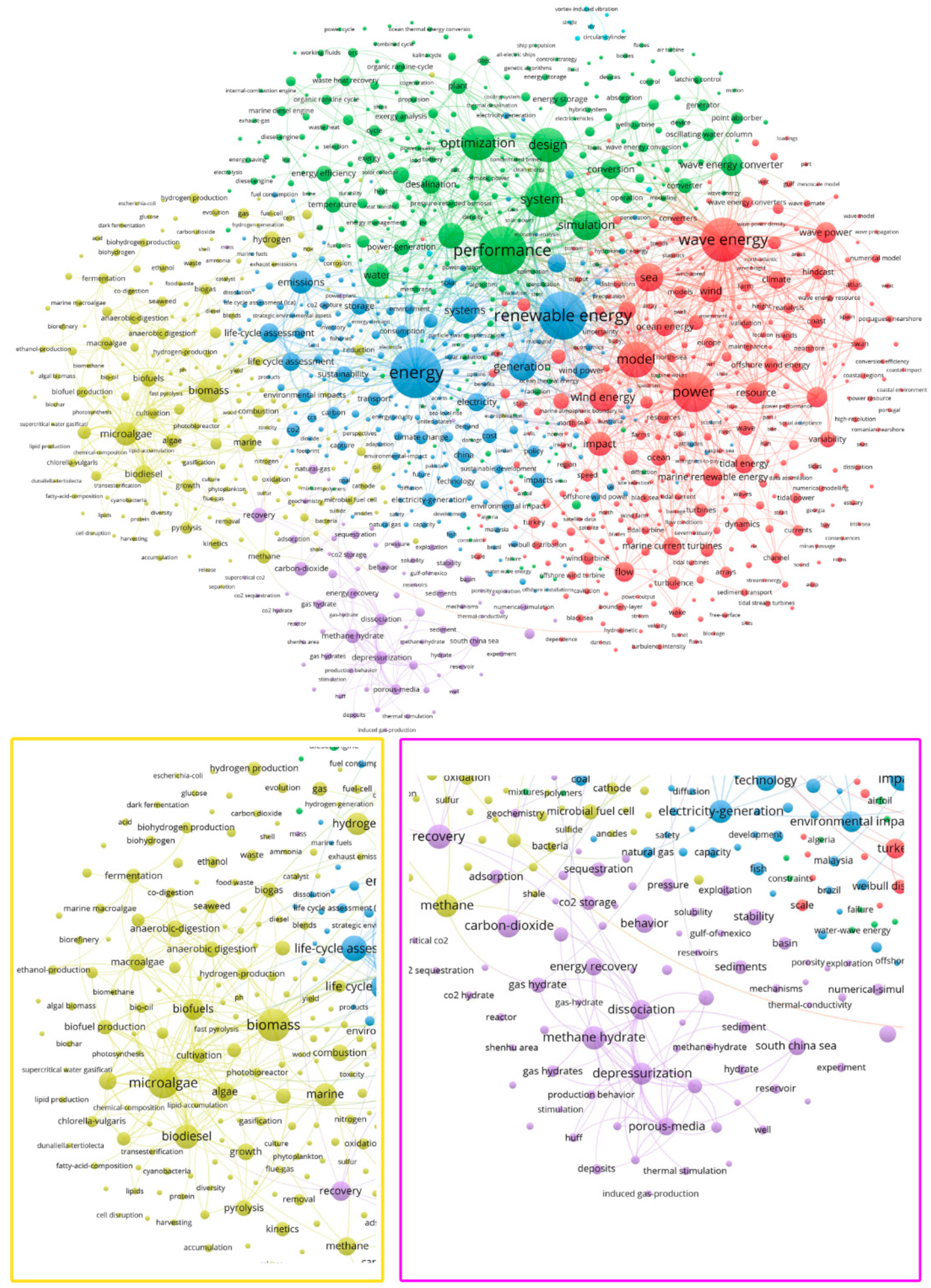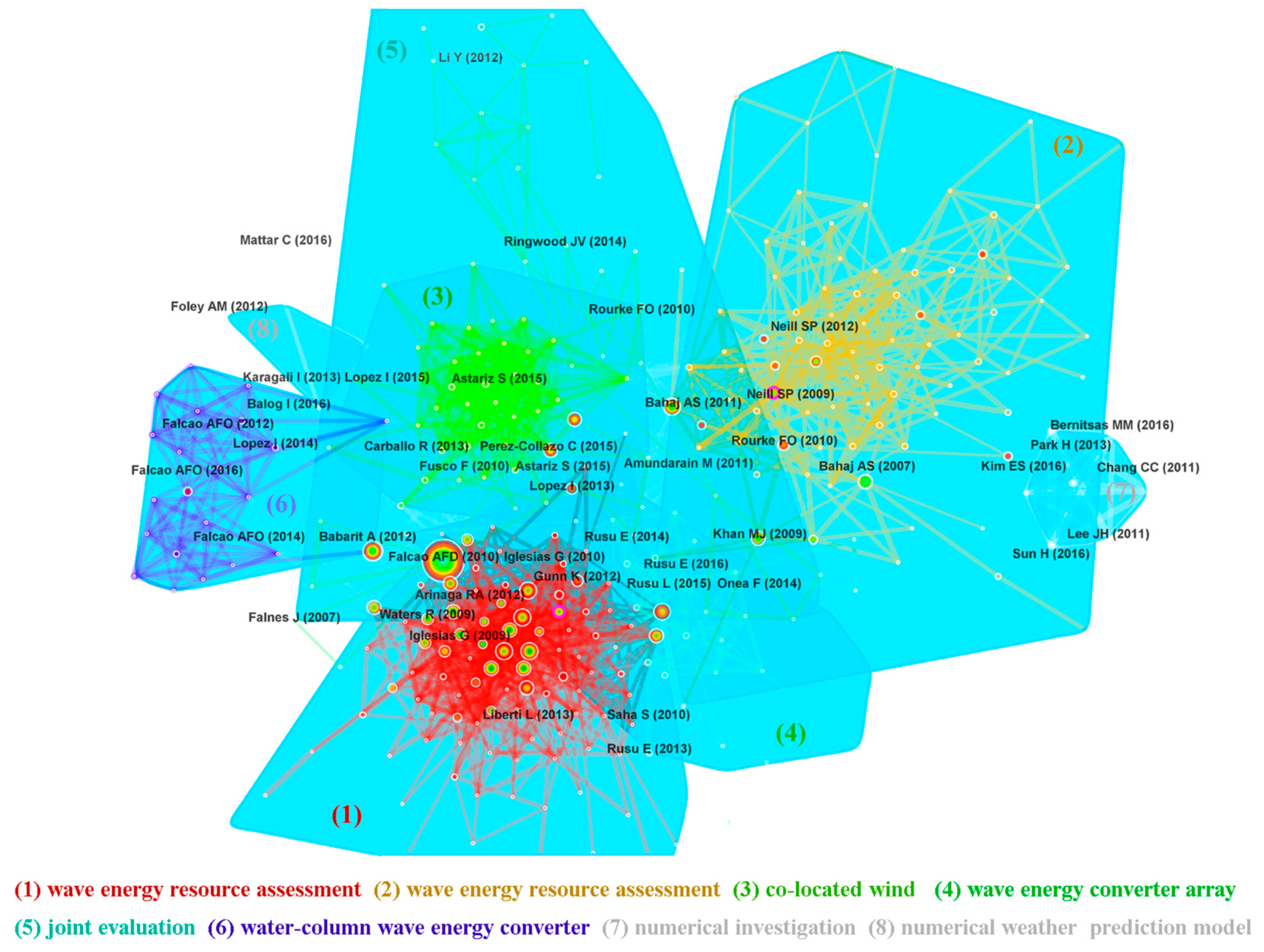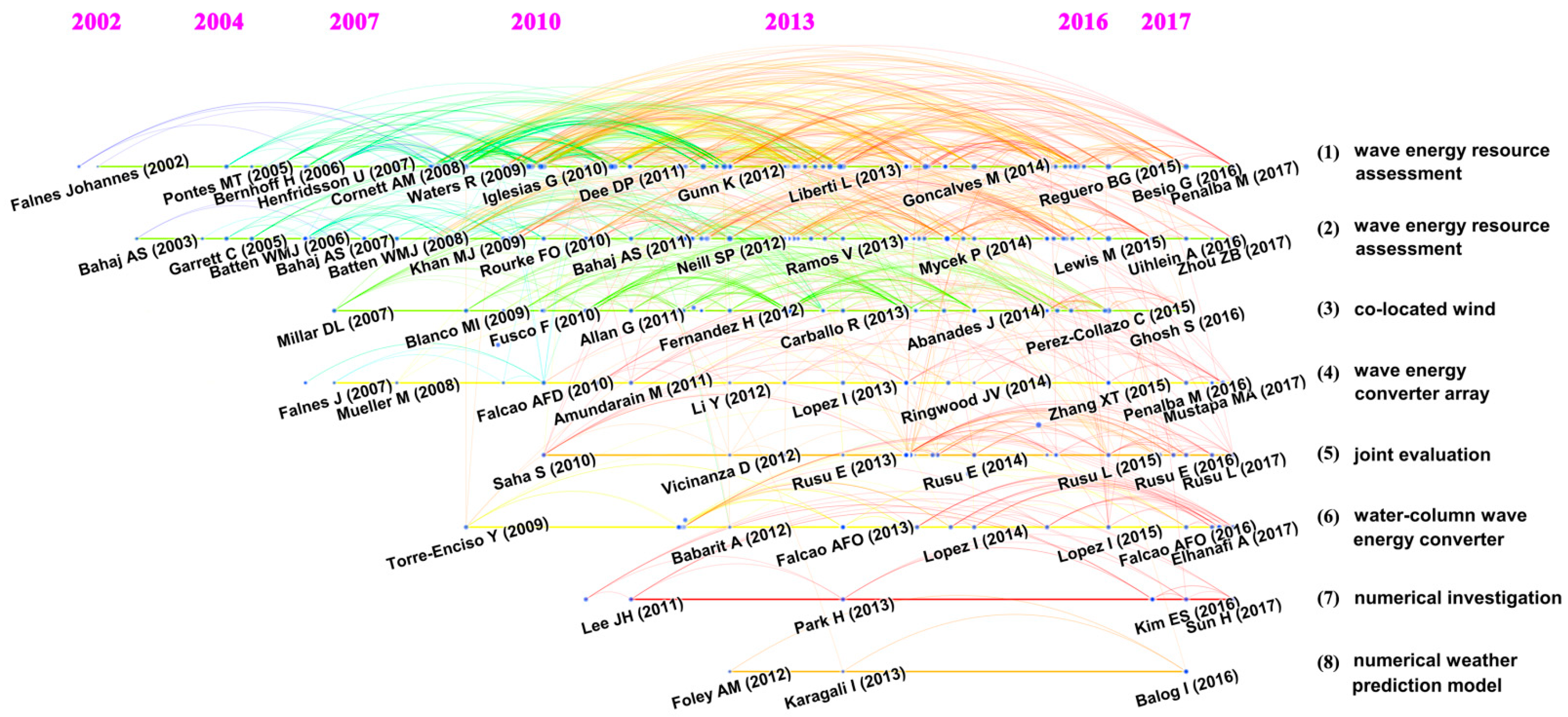4.1. Temporal Distribution Analysis of Global OPG Research
A total of 5262 articles researching on the OPG field from 1973 to 2018 were collected from the WOS core database. The number of annual publication and the total of cited times are shown in
Figure 1. As can be seen from the figure, only a small number of studies were published from 1973 to 1990, and the research topics are also mainly discussions of existing OPG stations, and the future potential and prospects of OPG [
28,
29,
30,
31]. From 1991 to 2006, the number of studies showed a slow upward trend from 22 (0.42%) to 69 (1.31%). During this period, the research mainly focused on the utilization of wave energy, wind energy and marine current energy, and the potentiality of marine biomass energy [
32,
33,
34,
35,
36,
37,
38,
39,
40,
41,
42]. The article of OPG research broke through 100 (n = 136, 2.58%) for the first time in 2007, and the cited times also exceeded 500 times (n = 619). In the following 10 years, the number of studies and times cited demonstrated a rapid growth trend. In 2018, the number of articles and cited times reached 706 (13.42%) and 17,150, respectively. We propose the reason is that the world has arrived at a consensus that the excessive carbon dioxide emissions and the sharp consumption of non-clean energy, such as oil, may bring great harm and potential threat to human survival. Therefore, various countries have begun to seek clean energy and have formulated and promulgated corresponding regulations and policies to promote the development of clean energy. For instance, in February 2005, the “Kyoto Protocol” signed by 84 countries came into effect, becoming one of the new driving forces for the development of clean energy in various countries, particularly in Europe [
43]. In August 2005, the United States issued the U.S. energy policy act, which was the first comprehensive energy policy since 1992. The act clearly states that it is necessary to encourage the research, development, and use of clean energy [
44]. By September 2005, 34 developed countries and 14 developing countries in the world had introduced different policies to promote the development of clean energy. A total of 32 of them had implemented a feed-in tariff, that is, to purchase clean energy power at a price higher than that of conventional fossil energy generation. At the same time, 35 developed countries and 100 developing countries set national clean energy development goals [
45]. There are huge clean energy resources in the ocean, which have the characteristics of ultra-low carbon emissions. Therefore, the research on ocean energy has attracted more researchers from different countries. Due to the delay of policy effects, and the time required for manuscript review and publication, the number of studies in the OPG field has also shown a rapid growth since 2007. In addition, in October 2003, the “Berlin Declaration on Open Access to Knowledge in the Sciences and Humanities” launched by the Max Planck Society extended the object of open access to research article. In this way, many OA articles were added in the WOS database for readers to read and cite. We propose that this was one of the driving factors for the increase of citations.
To know more about the changes in different countries’ attention to OPG over time, we conducted further statistical analysis on the top three countries with the number of studies, and the results are shown in
Figure 2. OPG research was first carried out in the United States, where Anderson published an article on solar energy to discuss the utilization of offshore solar energy [
46]. Only a few related studies were published before 1990 (n = 21). From 1991 to 2006, the number of publications showed a slow growth trend. During this period, a total of 143 studies were published. However, since 2007, the research articles published by the United States have been growing rapidly, with a total of 755 studies published by 2018. The United Kingdom began to publish OPG studies in 1977, but only a small number were published until 2006—a total of 88. Since 2007, the situation changed, and the publications showed a steady growth trend. By 2018, 503 studies had been published in 12 years. In China, the research on OPG started relatively late. From 1994 to 2006, only 35 studies were published. However, since 2007, the number of studies began increasing rapidly. In 2009, the number of annual publications exceeded the United Kingdom, and also exceeded the United States in 2015. Since 2017, China has ranked first in the world in the number of articles published each year. In addition, by 2018, the total of studies published by China ranked second in the world, which may result from the government encouragement and financial support for scientific research.
4.2. Global Spatial Distribution of OPG Research and National Collaboration
According to the statistical analysis, from 1973 to 2018, a total of 114 countries (or regions) published 6545 articles in the OPG field. As some of them were jointly published by several countries, we calculated the article once in each country. The results showed that a small number of countries/regions published most of the studies in the field, and the top 30 countries (or regions) published 5805 studies, accounting for about 88.69% of the total.
Figure 3 shows the global spatial distribution of OPG research. The color from light yellow to dark brown indicates that the number of studies is from less to more, and the red node represents the specific number in the country. The OPG research was mainly concentrated in North America, Europe, East Asia, West Asia, and Australia. Except for the United States, Brazil, Canada, China, and Australia, most of the other countries (or regions) are located in Europe, such as Britain, Italy, Spain, Norway, Germany, France, Denmark, Sweden, etc. These countries have long sea lines and highly developed industries, and they attach great importance to environmental protection.
The United States has the largest number of publications in the OPG field among all countries (n = 919), and it is also the largest node in the spatial distribution map. As can be seen from
Table 1, the studies from the United States also had the highest citations. China published 730 studies, ranking second. Next was the United Kingdom. If only the island of England is counted, about 424 studies were published. However, due to the high number of studies published by Wales, Scotland, and Northern Ireland, which belong to the UK, the United Kingdom ranked third in the total (n = 591). These were followed by Italy, Spain, Japan, Norway, Germany, France, Denmark, and the other countries (regions). If we look at European countries as a whole, the number of articles published accounts for almost half of the world total, ranking first in the world.
The research influence of a country (or region) usually needs to be considered from two aspects, one is the number of studies and the other is the citations. Generally, a country (or region) that published more studies has more citations. However, the number of studies and the total citations are not completely positively correlated, and the total number of citations cannot truly reflect a country’s influence in the field. Therefore, the average citation of studies was analyzed.
Table 1 shows the citations and average citations in the top 10 countries with publications. In the field of OPG, the United States had the most publications (n = 919), and the total citations (19,189) were also the most; however, the average citations ranked fourth (20.88). Many researchers in the United States are engaged in the research of different OPG technologies. Some of the technologies are very advanced, and have published many high-level articles, which are highly cited. In those areas, the technology is relatively weak, and the level of articles was relatively low, which affects the average impact factor. China ranked second in the number of publications (n = 730), third in the total number of citations (6230), and ninth in the average citations (12.58). This shows that there are many scholars engaged in OPG research in China; however, because it started late, the high-level articles published are relatively few, and the influence is weak. The number of British publications ranked third (n = 593), and the total and average citations (14575, 24.58) ranked second. Compared with the United States, the UK has fewer researchers in the field of OPG, but due to its early start and advanced technology, it has published more high-level articles and gained higher influence. There are a total of 10 countries with an average citation of more than 15, which are all European countries except the US. This shows that European countries have paid more attention to clean energy. After a long period of research, the level ranked in the forefront of the world, and the research results have a high impact. The number of articles published in Japan ranked sixth; however, most of its articles are published in academic conferences, and so the average citation is relatively low. We made a further analysis of the journals including articles from these 10 countries. The screening of the journals met two conditions. First, the number of articles published in this journal in each country was greater than or equal to 5, which indicates that the journal was the main published journal. Second, the impact factor of the journal was greater than or equal to 5. The analysis results are shown in
Table 2. The countries that published more than 100 high-level articles were the United Kingdom, the United States, China, and Spain, which to an extent reflects their international influence in the OPG field. This is consistent with the results of our previous citation analysis.
To study the activeness of different countries in the OPG field, we introduced centrality to express the central degree of a node in the whole network. As shown in
Table 1, the OPG research in the United States and the United Kingdom had a high between centrality, which means that the two countries play the important roles in the OPG field. As a bridge, they usually relate to the information exchange and interactions between different countries. China ranked second in the number of studies, but it had a lower between centrality compared with the two countries, which means that China may only play a role in connecting certain countries.
Through the analysis of country/region distribution, the distribution of global research forces in this field can be mastered, which provides a reference to conduct scientific research investigation and collaboration. After analyzing the number of national publications, we conducted a network analysis of the cooperative relations between different countries with more than 10 publications, which can reflect the exchange and communication of the subject to a certain extent.
Figure 4 shows the collaboration network between different countries with more than 10 publications. Here, the size of nodes represents the number of studies, and the links between them reflect the strength of collaboration.
Figure 4a shows the global collaboration relationships in the field of OPG. In the global scope, three countries (the United States, China, and the United Kingdom) play the bond roles, connecting other countries (regions) to establish a global collaboration network of OPG research.
Figure 4b shows the international collaboration relationships of the United States. The United States had collaborations with almost all countries (regions) in the world, and the United Kingdom and China had the strongest collaborations.
Figure 4c shows China’s international collaboration relationship. China’s main collaborators, except for Australia, the United States, Canada, and the United Kingdom, are mainly gathered in Asia, such as Japan, South Korea, Singapore, India, Malaysia, and other countries (regions), which indicates that China plays a local bond role in the global collaboration network.
Figure 4d shows the UK’s international collaboration relationships. The UK has strong collaboration relations with Australia, the United States, Canada and China. In addition, the UK has more collaborators gathered in Europe, such as Germany, France, Spain, the Netherlands, Italy, Denmark, Switzerland, Norway, etc., which mean that the UK plays an important local bond role in Europe. These results show that, as a global central bond, the United State links the two local core bonds (the United Kingdom and China), constructing a global collaboration network of the OPG field. In addition, the study also found that countries (regions) with larger international collaboration are also more productive. For instance, in the global collaboration network, the three countries with the largest strength of collaboration were the United Kingdom (342), China (235) and the United States (327), and their numbers of publications were also the top three in the world.
To further explore the cooperation relationships between countries, we analyzed the dynamic evolution of the global cooperation network. The results are shown in
Figure 5. As only a small number of relevant studies were published from 1973 to 1998, the cooperation between countries can be ignored. Starting with 1999, we made an analysis of the national cooperation network at intervals of four years. It can be seen from the figure that from 1999 to 2010, the UK was at the center of the national cooperation network. There were many cores in 2011–2014. In 2015–2018, the United States began to become a bridge between Britain and China. This shows that European countries have a long history in OPG research and more developed technologies. Therefore, they were in the central position of the cooperation network for a long time. China and the United States started relatively late but developed rapidly due to the greater support from the government.
4.3. Analysis of Hot Topics and Evolution Trends in the OPG Field
The title, abstract, and key words of scientific and technological article are often the core content used to explain or express the article. By analyzing the association and combination of the core words extracted from them, we can determine the microstructure and internal correlations of the research field. First of all, by calculating the frequency of the core words in the article, as well as the time distribution and change trends of these words, we can determine the research and development trends of this field. In addition, by analyzing the frequency of two core words appearing in the same article, we can form a co-word network composed of these word pairs. Through clustering analysis of these words of the co-word network, we can mine the changes of the topic structure represented by these words and identify the research hot topics and frontiers. We used the co-word analysis method to analyze the occurrence and co-occurrence frequencies of core words extracted from the titles, abstracts, and keywords of the OPG article, and we constructed the core words co-occurrence map with the visualization method, which clearly shows the frequency and clustering relationships of the core words. As shown in
Figure 5, each node represents a core word, and the size of the nodes represents the frequency of their occurrence.
If two nodes (core words) appear in the same article, the connection between them is established, and the links between them represent the strength of co-occurrence. The thicker the line is, the higher the frequency of co-occurrence of the core words is. As can be seen from the above, the development of OPG can be divided into two stages: the stable period (1973–2007) and the rapid rise period (2008–2018). In the stable period, only a small number of studies were published, while in the rapid rising period, the number of studies increased year by year. We believe that the attention and content of two periods of OPG research are different; thus, the co-word analysis was carried out for the two periods separately.
Figure 6 and
Figure 7 show the co-occurrence network of core words with more than five occurrences in the two periods. As shown in
Figure 6, during 1973–2007, there were not many high-frequency core words in the studies, and the number and frequency of co-occurrence word pairs were not high. This indicates that the OPG research had relatively low attention, and there was no obvious focused topic. We note that, during this period, under the background of global warming, OPG research mainly sought new energy sources with low carbon emissions from the ocean. The research mainly focused on the utilization of wave energy and the development, optimization, and simulation of various ocean energy turbines. At the same time, they also began to pay attention to the potential of wind and solar energy.
Figure 7 shows the co-occurrence relationship of core words from 2008 to 2018. It is very intuitive that the number and occurrence frequency of core words and the co-occurrence frequency of word pairs from 2008 to 2018 were much greater than those from 1973 to 2007. Compared with 1973–2007, there were more topics of OPG research in 2008–2018, and the focus was clearer. During this period, the OPG research was mainly divided into five parts: (1) We noticed that certain core words, like “sustainability”, “sustainable development”, “impact”, and “environmental impact”, appeared in the blue cluster of
Figure 6, and they had a relatively large weight in network. These core words rarely appeared in the co-occurrence network (1973–2007). This shows that, in the past 10 years, while it was also in the context of low-carbon energy demand, compared with the previous studies, researchers began to care about the sustainability of energy and the pollution of the marine environment, which was not focused on in previous studies. (2) More attention was paid to marine bioenergy, such as using algae to produce biofuels, including hydrogen, ethanol, biodiesel, etc. (3) Different from 1973–2007, the research on gas hydrates in recent 10 years have been paid more and more attention. With the high storage, high calorific value, and low pollution, gas hydrates have great utilization potential, but the technical requirements for its exploitation are also high. Therefore, only a few countries can mine gas hydrates from the seabed at present. China’s gas hydrate mining technology is in the leading position in the world. In May 2017, China achieved continuous and stable gas production for the first time in the world (for more than one week) in the Shenhu sea area of the South China Sea. (4) In terms of energy types, previous studies focused on wave energy, and the utilization of tidal energy became a hot spot. In addition, the research, development, and optimization of turbines for wave and tidal energy in recent years were also the hot spots. (5) Compared with
Figure 6, many core words, like “energy storage”, “storage”, “energy management”, and “policy”, appear in
Figure 7. We propose the reason is that while more ocean energy can be developed and utilized, how to store, manage, and use these energies is also a key problem in OPG research.
Co-citation analysis can find out the relationship of studies and find the research hot topics and frontiers. The nodes in
Figure 8 were used to distinguish studies, which are marked with the first author and the publication year. The size of the nodes reflects the citation times, the lines indicates the co-citation relationship, and the thickness of the lines reflects the co-citation strength. In addition, different colors represent the clusters, each cluster has a label to summarize the research direction or topic, and the nodes within the same color belong to the same cluster.
According to the co-citation and cooperation relationship, a total of eight clusters were formed. The topics of cluster 1 and 2 both wave energy resource assessment, but they are divided into two categories because of their different cooperation networks. The other six topics are co-located wind, wave energy converter array, joint evaluation, water-column wave energy converter, numerical calculation, and numerical weather prediction model. The results show that, although many marine resources have been used for power generation, more attention has been paid to wave energy due to its great potential, especially in European countries. Britain’s wave energy technology is at the leading level in the world (clusters 1 and 2). Wind and wave energy can be obtained at the same place in the ocean, and both industries are considering how to reduce energy costs. At present, the wind power technology is relatively mature, and the offshore floating wind and wave energy converter technology is also developing rapidly. Therefore, how to combine a variety of technologies to produce co-located developments for obtaining wind and wave energy at the same location at the same time is one of the hot topics going forward (cluster 3). In the energy sources, the research no longer only considered the potential of one kind of energy, but also began to estimate the joint storage and application potential of wind and wave energy through numerical calculations. In terms of equipment, the acquisition and conversion mechanisms of wind and wave energy are different. Under the premise of joint acquisition and utilization of the two energies, the development of equipment for efficient use and collaborative operation is a key point (cluster 5). At the same time, due to the difficulty of ocean engineering and the extreme waves and gales condition, the durability of equipment is also particularly important in the construction process of wave energy engineering. At present, oscillating water columns have received more attention (clusters 4 and 6). In the process of using ocean energy, the weather conditions are also an important factor. Accurate and timely weather prediction is crucial for the stable and efficient operation of energy conversion devices. The existing land numerical weather prediction models cannot be fully used for ocean weather prediction. Thus, it is also an important direction of OPG research to establish a suitable numerical weather prediction model to predict the ocean weather (clusters 7 and 8).
As shown in
Figure 9, after cluster analysis, we presented a timeline view of the clustering structure, which displays the time distribution of studies of different research topics. The advantage of this analysis is to better reveal the development trajectory and evolution process of the knowledge structure of OPG over time [
47].
Among the eight clustering topics, the evaluation of wave energy resources is relatively early. Among all the ocean energy, wave energy has the advantages of high energy density and wide distribution, which has great potential and has always been the focus of attention. As shown in
Figure 9, since 2002 many scholars have started the research on wave energy resource assessment. With the development of science and technology, researchers of wave energy begin to pay attention to the joint exploitation of wind energy and wave energy at the co-location around 2007, to improve the energy utilization efficiency and reduce the cost of using complex structures. This also is the third cluster in
Figure 9. With the prospect of wave energy becoming more and more clear, the development of wave energy power generation equipment has become a research hot topic since 2009 (cluster 4 and 6).
From 2010, the assessment of energy storage changed from single wave energy to the joint evaluation of wave energy and wind energy (cluster 5). In addition, the utilization of ocean energy has the problems of complex marine environments and high engineering costs. It is difficult to verify novel equipment or technology in a real environment. The research on wave energy using numerical simulation technology can help with this problem when the experiment cannot be carried out in the real environment or the engineering cost is too high, which became a hot topic from 2011. When using wave energy to generate electricity, the equipment is at high risk of damage under extreme waves and gale conditions. In addition, for the development of wave energy, not all wave heights can be used. Waves that are too small will not drive the power generation device, and waves that are too large will cause damage. Therefore, timely adjustment of the operation status of the equipment according to the weather conditions is conducive to the stable and efficient acquisition of wave energy. To a certain extent, weather prediction is helpful to reduce the damage of abnormal weather to equipment and improve the utilization efficiency of wave energy (cluster 8).
